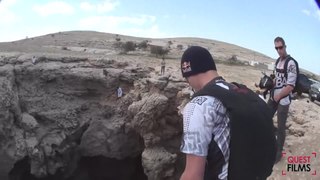
BASE jumping is the recreational sport of jumping from fixed objects, using a parachute to descend safely to the ground. "BASE" is an acronym that stands for four categories of fixed objects from which one can jump: buildings, antennae, spans (bridges), and earth (cliffs). Participants exit from a fixed object such as a cliff, and after an optional freefall delay, deploy a parachute to slow their descent and land. A popular form of BASE jumping is wingsuit BASE jumping.
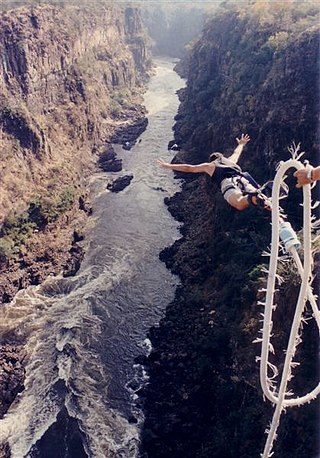
Bungee jumping, also spelled bungy jumping, is an activity that involves a person jumping from a great height while connected to a large elastic cord. The launching pad is usually erected on a tall structure such as a building or crane, a bridge across a deep ravine, or on a natural geographic feature such as a cliff. It is also possible to jump from a type of aircraft that has the ability to hover above the ground, such as a hot-air-balloon or helicopter. The thrill comes from the free-falling and the rebound. When the person jumps, the cord stretches and the jumper flies upwards again as the cord recoils, and continues to oscillate up and down until all the kinetic energy is dissipated.

The New River Gorge Bridge is a steel arch bridge 3,030 feet (924 m) long over the New River Gorge near Fayetteville, West Virginia, in the Appalachian Mountains of the eastern United States. With an arch 1,700 feet (518 m) long, the New River Gorge Bridge was the world's longest single-span arch bridge for 26 years; it is now the fifth longest; the longest outside of China. Part of U.S. Route 19, its construction marked the completion of Corridor L of the Appalachian Development Highway System. An average of 16,200 motor vehicles cross the bridge each day.

Wingsuit flying is the sport of skydiving using a webbing-sleeved jumpsuit called a wingsuit to add webbed area to the diver's body and generate increased lift, which allows extended air time by gliding flight rather than just free falling. The modern wingsuit, first developed in the late 1990s, uses a pair of fabric membranes stretched flat between the arms and flanks/thighs to imitate an airfoil, and often also between the legs to function as a tail and allow some aerial steering.
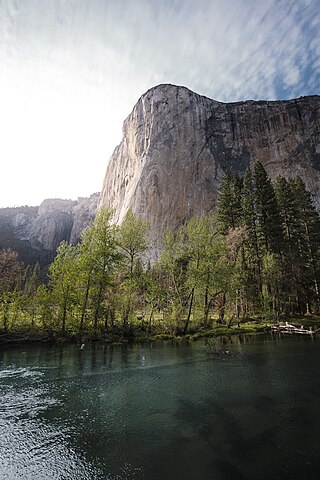
El Capitan is a vertical rock formation in Yosemite National Park, on the north side of Yosemite Valley, near its western end. The granite monolith is about 3,000 feet (914 m) from base to summit along its tallest face and is a world-famous location for big wall climbing, including the disciplines of aid climbing, free climbing, and more recently for free solo climbing.

The Parachutist Badge, also commonly referred to as "Jump Wings", is a military badge of the United States Armed Forces. Some services, such as the Marine Corps, officially refer to it as an insignia instead of a badge. The United States Space Force and United States Coast Guard are the only branches that do not award the Parachutist Badge, but their members are authorized to receive the Parachutist Badges of other services in accordance with their prescribed requirements. The DoD military services are all awarded the same Military Parachutist Badge. The U.S. Army and U.S. Air Force issue the same Senior and Master Parachutist Badges while the U.S. Navy and U.S. Marine Corps issue the Navy and Marine Corps Parachutist Insignia to advanced parachutists. The majority of the services earn their Military Parachutist Badge through the U.S. Army Airborne School.

Royal Robbins was one of the pioneers of American rock climbing. After learning to climb at Tahquitz Rock, he went on to make first ascents of many big wall routes in Yosemite. As an early proponent of boltless, pitonless clean climbing, he, along with Yvon Chouinard, was instrumental in changing the climbing culture of the late 1960s and early 1970s by encouraging the use and preservation of the natural features of the rock. He went on to become a well-known kayaker.
A suicide bridge is a bridge used frequently by people to end their lives, most typically by jumping off and into the water or ground below. A fall from the height of a tall bridge into water may be fatal, although some people have survived jumps from high bridges such as the Golden Gate Bridge. However, significant injury or death is far from certain; numerous studies report minimally injured persons who died from drowning.

Jim Bridwell was an American rock climber and mountaineer, active from 1965 in Yosemite Valley, but later in Patagonia and Alaska. He was noted for pushing the standards of both aid climbing and big wall climbing, and later alpine climbing. He wrote numerous articles on climbing and developed several important pieces of aid climbing equipment. Bridwell was an apprentice to Royal Robbins and Warren Harding, and later the unofficial leader of the Stonemasters.
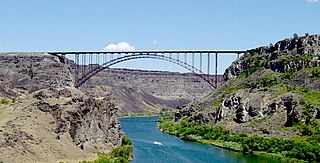
The I. B. Perrine Bridge is a four-lane truss arch span over the Snake River in the western United States. Located in southern Idaho just north of the city of Twin Falls, it carries U.S. Highway 93 over the Snake River Canyon, connecting Twin Falls County with Interstate 84 in Jerome County.

Carl Ronald Boenish, considered the father of modern BASE jumping, was an American freefall cinematographer, who in 1978 filmed the first jumps from El Capitan using ram-air parachutes.

Felix Baumgartner is an Austrian skydiver, daredevil and BASE jumper. He is widely known for jumping to Earth from a helium balloon from the stratosphere on 14 October 2012 and landing in New Mexico, United States, as part of the Red Bull Stratos project. Doing so, he set world records for skydiving an estimated 39 km (24 mi), reaching an estimated top speed of 1,357.64 km/h (843.6 mph), or Mach 1.25. He became the first person to break the sound barrier relative to the surface without vehicular power on his descent. He broke skydiving records for exit altitude, vertical freefall distance without a drogue parachute, and vertical speed without a drogue. Though he still holds the two latter records, the first was broken two years later, when on 24 October 2014, Alan Eustace jumped from 135,890 feet with a drogue.

Bridge Day is an annual one-day festival in Fayetteville, Fayette County, West Virginia, United States The event is coordinated by the New River Gorge Bridge Day Commission, and is sponsored by numerous companies of both local and international significance. The event, held on the third Saturday every October, commemorates the 1977 completion of the New River Gorge Bridge. On this day, all four lanes of the bridge are closed to automobiles and opened to pedestrians. Estimates have 100,000 people attending the overall event.
Todd Richard Skinner was an American rock climber and expert in big wall climbing. He made the first free ascents of many routes around the world, including his historic first free ascent with Paul Piana in 1988 of the Salathe Wall on El Capitan in Yosemite; it was one of the first-ever big wall climbs at 5.13b (8a), and led to the birth of "free climbing" Yosemite.

Dean Spaulding Potter was an American free climber, alpinist, BASE jumper, and highliner. He completed many hard first ascents, free solo ascents, speed ascents, and enchainments in Yosemite National Park and Patagonia. In 2015, he died in a wingsuit flying accident in Yosemite National Park.
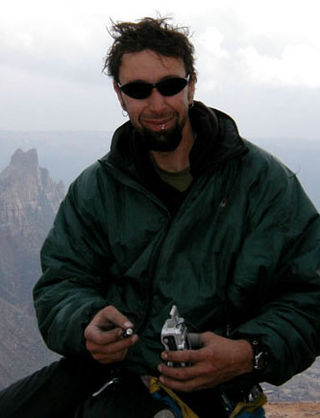
Ammon McNeely was an American rock climber who specialized in big wall climbing and aid climbing, and who set many speed climbing records and made the first "one-day ascent" for many climbing routes on El Capitan in Yosemite. His other interests included BASE jumping and wingsuiting. McNeely was also a slackliner and pioneered many highlines throughout the US.

Stephanie "Steph" Davis is an American rock climber, BASE jumper, and wingsuit flyer. She is one of the world's leading climbers, having completed some of the hardest routes in the world. She has free soloed up to 5.11a (6b+), and was the first woman to summit all the peaks of the Fitzroy Range in Patagonia, the second woman to free climb El Capitan in a day, the first woman to free climb the Salathė Wall on El Capitan, the first woman to free solo The Diamond on Longs Peak in Colorado, and the first woman to summit Torre Egger. Davis was married to fellow climbers and BASE jumpers Dean Potter and Mario Richard, and currently to sky-diving instructor, flyer, and jumper Ian Mitchard. Davis is also a blogger who writes about her interests in climbing, BASE jumping, yoga, and veganism.
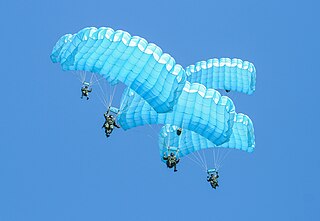
Parachuting and skydiving is a method of transiting from a high point in an atmosphere to the ground or ocean surface with the aid of gravity, involving the control of speed during the descent using a parachute or parachutes.
Dwain Weston was an Australian skydiver, BASE jumper and wingsuiter. On 5 October 2003, at the end of the inaugural Go Fast Games, Weston was killed while attempting to fly over the Royal Gorge Bridge near Cañon City, Colorado, United States.

Ski-BASE jumping is the recreational sport of skiing at a high speed off of a cliff or mountain and free-falling through the air, using a parachute to descend to the ground, therefore combining the two sports of skiing and BASE jumping. Participants often perform tricks or manoeuvres during the freefall and remove their skis mid-air in order to safely deploy the parachute and land.
















